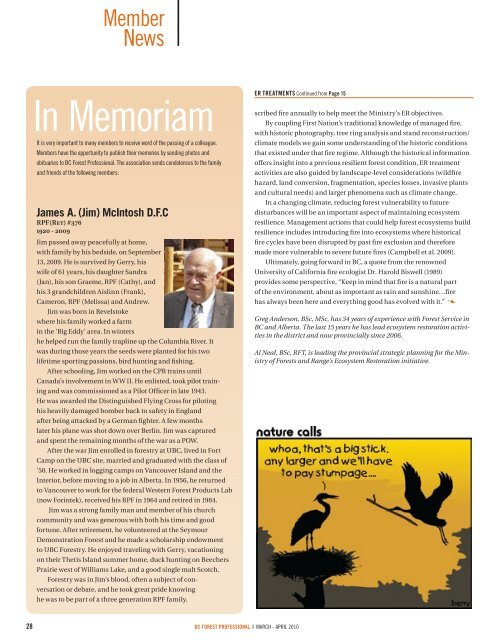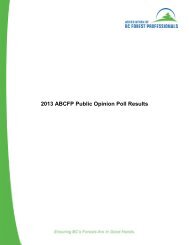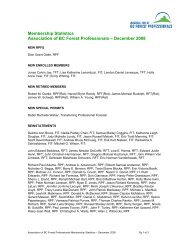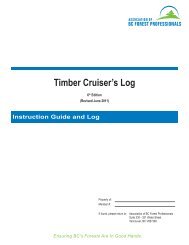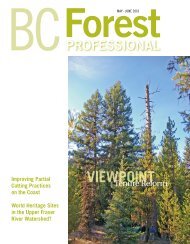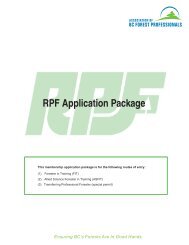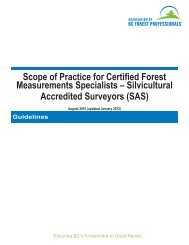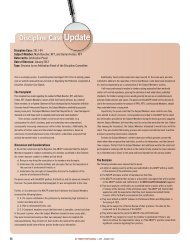VIEWPOINT - Association of BC Forest Professionals
VIEWPOINT - Association of BC Forest Professionals
VIEWPOINT - Association of BC Forest Professionals
Create successful ePaper yourself
Turn your PDF publications into a flip-book with our unique Google optimized e-Paper software.
Member<br />
News<br />
in Memoriam<br />
it is very important to many members to receive word <strong>of</strong> the passing <strong>of</strong> a colleague.<br />
Members have the opportunity to publish their memories by sending photos and<br />
obituaries to <strong>BC</strong> <strong>Forest</strong> pr<strong>of</strong>essional. The association sends condolences to the family<br />
and friends <strong>of</strong> the following members:<br />
James A. (Jim) McIntosh D.F.C<br />
RPF(Ret) #376<br />
1920 - 2009<br />
Jim passed away peacefully at home,<br />
with family by his bedside, on September<br />
13, 2009. He is survived by Gerry, his<br />
wife <strong>of</strong> 61 years, his daughter Sandra<br />
(Jan), his son Graeme, RPF (Cathy), and<br />
his 3 grandchildren Aislinn (Frank),<br />
Cameron, RPF (Melissa) and Andrew.<br />
Jim was born in Revelstoke<br />
where his family worked a farm<br />
in the ‘Big Eddy’ area. In winters<br />
he helped run the family trapline up the Columbia River. It<br />
was during those years the seeds were planted for his two<br />
lifetime sporting passions, bird hunting and fishing.<br />
After schooling, Jim worked on the CPR trains until<br />
Canada’s involvement in WW II. He enlisted, took pilot training<br />
and was commissioned as a Pilot Officer in late 1943.<br />
He was awarded the Distinguished Flying Cross for piloting<br />
his heavily damaged bomber back to safety in England<br />
after being attacked by a German fighter. A few months<br />
later his plane was shot down over Berlin. Jim was captured<br />
and spent the remaining months <strong>of</strong> the war as a POW.<br />
After the war Jim enrolled in forestry at U<strong>BC</strong>, lived in Fort<br />
Camp on the U<strong>BC</strong> site, married and graduated with the class <strong>of</strong><br />
’50. He worked in logging camps on Vancouver Island and the<br />
Interior, before moving to a job in Alberta. In 1956, he returned<br />
to Vancouver to work for the federal Western <strong>Forest</strong> Products Lab<br />
(now Forintek), received his RPF in 1964 and retired in 1984.<br />
Jim was a strong family man and member <strong>of</strong> his church<br />
community and was generous with both his time and good<br />
fortune. After retirement, he volunteered at the Seymour<br />
Demonstration <strong>Forest</strong> and he made a scholarship endowment<br />
to U<strong>BC</strong> <strong>Forest</strong>ry. He enjoyed traveling with Gerry, vacationing<br />
on their Thetis Island summer home, duck hunting on Beechers<br />
Prairie west <strong>of</strong> Williams Lake, and a good single malt Scotch.<br />
<strong>Forest</strong>ry was in Jim’s blood, <strong>of</strong>ten a subject <strong>of</strong> conversation<br />
or debate, and he took great pride knowing<br />
he was to be part <strong>of</strong> a three generation RPF family.<br />
ER TREATMENTS Continued from Page 15<br />
28 <strong>BC</strong> FOREST PROFESSIONAL | MARCH - ApRil 2010<br />
scribed fire annually to help meet the Ministry’s ER objectives.<br />
By coupling First Nation’s traditional knowledge <strong>of</strong> managed fire,<br />
with historic photography, tree ring analysis and stand reconstruction/<br />
climate models we gain some understanding <strong>of</strong> the historic conditions<br />
that existed under that fire regime. Although the historical information<br />
<strong>of</strong>fers insight into a previous resilient forest condition, ER treatment<br />
activities are also guided by landscape-level considerations (wildfire<br />
hazard, land conversion, fragmentation, species losses, invasive plants<br />
and cultural needs) and larger phenomena such as climate change.<br />
In a changing climate, reducing forest vulnerability to future<br />
disturbances will be an important aspect <strong>of</strong> maintaining ecosystem<br />
resilience. Management actions that could help forest ecosystems build<br />
resilience includes introducing fire into ecosystems where historical<br />
fire cycles have been disrupted by past fire exclusion and therefore<br />
made more vulnerable to severe future fires (Campbell et al. 2009).<br />
Ultimately, going forward in <strong>BC</strong>, a quote from the renowned<br />
University <strong>of</strong> California fire ecologist Dr. Harold Biswell (1989)<br />
provides some perspective, “Keep in mind that fire is a natural part<br />
<strong>of</strong> the environment, about as important as rain and sunshine…fire<br />
has always been here and everything good has evolved with it.” 3<br />
Greg Anderson, BSc, MSc, has 34 years <strong>of</strong> experience with <strong>Forest</strong> Service in<br />
<strong>BC</strong> and Alberta. The last 15 years he has lead ecosystem restoration activities<br />
in the district and now provincially since 2006.<br />
Al Neal, BSc, RFT, is leading the provincial strategic planning for the Ministry<br />
<strong>of</strong> <strong>Forest</strong>s and Range’s Ecosystem Restoration initiative.


